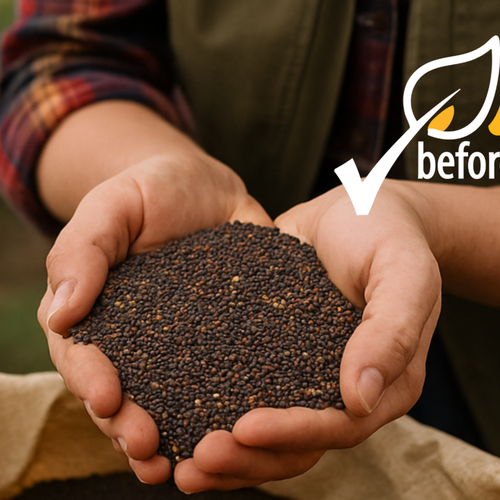No-till farming has positively increased moisture retention and organic matter, reduced erosion and made a kinder habitat for beneficial insects.
But there is a downside.
This improved ecosystem creates friendlier environs for slugs and snails to thrive.
The increase in mollusc numbers and geographical spread since intense cultivation ended is significant and means pest control has become a crucial part of crop planning for farmers and agronomists.
An IPM program such as the CDC recommended burn ‘em, bash ’em, bait ‘em’ system is important, but burning is socially difficult in many areas and mechanical control is often impractical.
Baiting is now the standard method for protecting precious crops.
Australian farmers have many brands of bait available to them but the key to making better choices and getting the most cost-efficient protection understanding the two very different classes of bait available and their characteristics.

Craig Wood of Agspec Australia explains the differences: “The most commonly used products are what we call short window baits”.
He says these are bran-based pellets coated with metaldehyde and are commercial versions of baits people might use in home gardens.
“These products are built to a price, and although they control pests for a short time, they have shortcomings,” Craig says.
“You must apply a lot of bait often, the pellets aren’t durable so they often crush during application, they’re dusty to apply and they only provide control for a few days,” he says.
“In fact, in wet conditions when we see high pest numbers, these baits disintegrate in a day or two from rainfall leaving a crop unprotected until replication occurs.”
The second type of bait Craig talks about are modern ‘long window’ baits.
He says these baits are designed to deliver longer protection due to their ability to withstand tough weather conditions.
But for how long?
“That really depends on the technology of the bait matrix used by respective manufacturers, but some last a week or so, others 2-3 weeks,” Craig explains.
“And now, there is a versatile option available to farmers that delivers outstanding protection for even longer,” he says.
“Agspec is proud to market Axcela, a game-changing solution which can withstand weeks of adverse weather whilst giving unparalleled protection to plants.”
Axcela is a breakthrough in long term protection against mollusc pests.
Its unique gelatinous bait matrix was developed by the company that invented metaldehyde, Arxada. Arxada’s focus when developing Axcela was to ensure it outperformed competitors in crucial benchmarks such as spreading ballistics, bait durability and rapid activation when minimal moisture is present.
Molluscs require only a little moisture to become active in autumn, and Axcela immediately responds as it only requires a heavy dew to activate, and its outstanding palatability ensures super-fast control.
Additionally, Axcela’s unique formulation swells with moisture contact to make pellets almost double in size.
This novel feature literally presents another 80 per cent of physical bait to slugs and snails which is of huge benefit when pest numbers are high.

“Agspec introduced Axcela to Australia about three years ago in successive seasons of incredibly intense slug pressure in Australia,” Craig says.
“After seeing Axcela perform in a range of crops all over Australia, farmers, agronomists and contractors have been delighted with the speed and level of control,” he says.
“However, they especially value the remarkable weather fastness and length of protection offered by Axcela.
“The unsurpassed longevity of Axcela gives farmers real peace of mind when crops are vulnerable.
“After all, this early phase is where crop yield is often dictated – and crop damage from slugs often means a less-than-ideal finish and poorer paycheque come harvest.”
Farming is a price sensitive business, and this often sways farmers and agronomists when it comes to selecting a mollusc control option. Short window baits are usually cheaper per hectare than a ‘long window’ option to purchase, so many default to ‘cheaper’ baits and accept lesser protection to reduce initial cost.
“They aren’t comparing apples to apples,” Craig says.
“The important factor is the cost of protection per hectare for a given period compared to a product like Axcela,” he says.
“The initial price may be higher for a product like Axcela, but bran or lesser baits only protect for days while Axcela can protect a crop for weeks.”
To illustrate, let’s say the first five weeks of a crop from sowing is when it is most vulnerable to damage:
• Assume bait cost per hectare is approximately $20 for short window bait and $70 for Axcela.
• The cost of application is $5/ha for fuel, depreciation, labour, etc for each application.
• First application is at seeding and pest pressure is quite heavy so (at least) four applications of ‘cheaper’ short window bait are required over 35 days at 10-day intervals.
The actual cost for the same timeframe, but inferior protection is far higher using a bran-based bait, and:
• This is not considering crop damage that occurs between applications of short window bait when the crop is literally unprotected.
• The Axcela treated crop incurs less mechanical damage and less stress is placed on operators and machinery.
• Your time spent applying bait is reduced by 50-75 per cent with Axcela.
“If you extrapolate this model further to include competitor long window baits at label rates, at their average retail cost and their average bait lifetime, you find that the cost of protection per hectare, per day with Axcela makes it easily the best value, most effective bait on the market,” Craig adds.
“It protects your crop from pest damage far better without the multiple applications and the intermittent protection offered by inferior baits,” he says.
Axcela is available from your local rural reseller. For further information call your local Agspec business manager.




